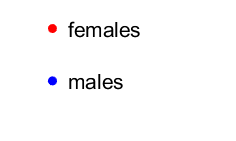Predictions & Data for this entry
| Model: std | climate: BWk | migrate: | phylum: |
| COMPLETE = 2.2 | ecozone: TN | food: biHl | class: |
| MRE = 0.017 | habitat: 0iTs | gender: Dg | order: |
| SMSE = 0.001 | embryo: Tv | reprod: O | family: |
Zero-variate data
| Data | Observed | Predicted | (RE) | Unit | Description | Reference |
|---|---|---|---|---|---|---|
| tp | 2555 | 2402 | (0.06001) | d | time since birth at puberty | CabeBore2015 |
| tpm | 2190 | 2378 | (0.08606) | d | time since birth at puberty | CabeBore2015 |
| am | 4380 | 4379 | (0.0001425) | d | life span | CabeBore2015 |
| Lb | 3 | 3.004 | (0.001294) | cm | SVL at birth | guess |
| Lp | 8.3 | 7.939 | (0.04351) | cm | SVL at puberty for females | CabeBore2015 |
| Lpm | 7.9 | 7.611 | (0.03654) | cm | SVL at puberty for males | CabeBore2015 |
| Li | 8.98 | 9.084 | (0.01154) | cm | ultimate SVL for females | CabeBore2015 |
| Lim | 8.69 | 8.708 | (0.002051) | cm | ultimate SVL for males | CabeBore2015 |
| Wwi | 25.4 | 25.38 | (0.0006681) | g | ultimate wet weight for females | guess |
| Ri | 0.00274 | 0.002743 | (0.001076) | #/d | maximum reprod rate | PianIbar2006 |
Uni- and bivariate data
| Data | Figure | Independent variable | Dependent variable | (RE) | Reference |
|---|---|---|---|---|---|
| tL_f |   | time since birth | SVL | (0.03471) | CabeBore2015 |
| tL_m |   | time since birth | SVL | (0.02622) | CabeBore2015 |
Pseudo-data at Tref = 20°C
| Data | Generalised animal | Phymaturus spurcus | Unit | Description |
|---|---|---|---|---|
| v | 0.02 | 0.02038 | cm/d | energy conductance |
| kap | 0.8 | 0.8397 | - | allocation fraction to soma |
| kap_R | 0.95 | 0.95 | - | reproduction efficiency |
| p_M | 18 | 19.69 | J/d.cm^3 | vol-spec som maint |
| k_J | 0.002 | 0.002011 | 1/d | maturity maint rate coefficient |
| kap_G | 0.8 | 0.8004 | - | growth efficiency |
Discussion
- Males are assumed to differ from females by {p_Am} only
- Temperatures are guessed; temp for tL_data varies seasonally -5 C till 27 C
- mod_1: males have equal state variables at b, compared to females
Facts
- Viviparous; males and females similar in size and growth, herbivorous (Ref: PianIbar2006)
Bibliography